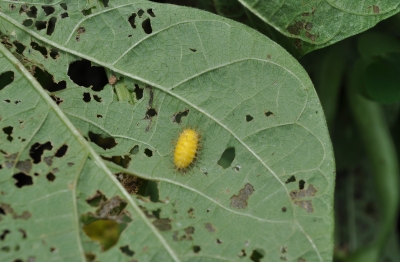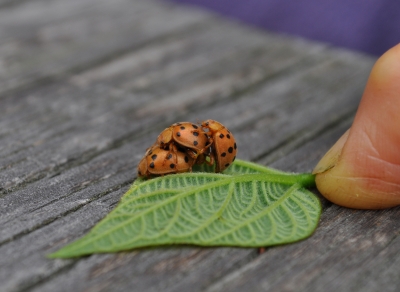Plagues Come & Go, With Some Help, and Seattle-time
Meet me in St. L . . . Seattle
Come hear me lecture on August 10, 2014 on “Luscious Landscaping, with Fruiting Trees, Shrubs, and Vines” at 1 pm in the Garden Room at Magnuson Park. For more information, go to http://www.brownpapertickets.com/event/755459.
Plague again; keep calm
Every year it seems some new plague is ready to attack plants. A few years ago, late blight of tomato moved to the fore. Emerald ash borer, threatening ash trees, was first found on our shores in 2002. (Figuratively; literally, the insect, native to Asia, was first noted in Michigan.) What’s next?
Perhaps a calmer outlook is called for. A decade or so garlic mustard seemed ready to take over our world. Not so, now, perhaps because it’s being crowded out by Japanese stilt grass, which itself seems now ready to take over our world. Garlic mustard is native over much of the northern hemisphere, except North America, and was introduced here around 1860 as a culinary herb. As for stilt grass, it hitchhiked here from China about a century ago, as packing material for porcelain. It’s deer-resistant, for what that’s worth.
Plant problems come and go. The best approach is to keep calm and, in some cases, plant something different, something plague resistant.
Bean Beetle Management
Green beans are a mainstay of my garden, of just about every garden. More than 20 years ago, Mexican bean beetles (a species of ladybug!) found my bean plants and have plagued them every year since.
The adults, with eight black spots over a red or yellow background, wake up late from winter sleep to lay eggs on bean leaves. I’ve come to despise the yellow, balled up spiny larvae that gorge on leaves and other plant parts.
Still, I have managed to grow good crops of beans over the years, not by killing the beetles or their larvae, but by growing a different plant. Sort of. Rather than grow pole beans, which reside in the garden all season long to provide a constant source of beetle food, I have been planting successive crops of bush beans. Bush bean plants tend to bear quickly and for about 3 weeks, then peter out, so a new planting in a new bed goes into the ground every 3 weeks from mid-May until late July.
Yield from a planting tapers off just as its resident beetle population is beginning a feeding frenzy. Then it’s time to pull up the plants, thoroughly clear the bed of leaves and old pods, and rush it all to the compost pile. Chopping the debris with a machete and burying it beneath straw and manure, and watering the pile, as needed, sends the temperature soaring, killing most of the beetles. Bean beetles are good fliers, so cooking the beetles in the compost pile doesn’t solve the problem, just keeps it under control.
Death to the beetles, with restraint
Something strange happened this year: As of this writing, only one beetle larvae has been seen. Last year I doused the bean plants a few times with one of two organic sprays, which gave good beetle control. It also gave me the confidence to try growing pole beans, as I did in my pre-Mexican bean beetle days. They got some bean beetles but we did harvest pole beans.
The sprays were Entrust and Azamax, both approved for organic agriculture. The active ingredient in Entrust is spinosad, a compound found in bacteria, Saccharopolyspora spinosa, that was isolated from soil collected inside an old rum still in the Virgin Islands. Although toxic to a range of insects, it is otherwise relatively benign. Still, the label requires waiting at least 3 days to harvest after spraying.
Azamax is an extract of the seed of the tropical neem tree, native to the Indian subcontinent. In that part of the world, this one tree has been used as human food, insect repellant, bird repellant, and an ingredient of soap. It degrades rapidly in soil or in water, and is harmless to earthworms, honeybees, and insect predators. Food crops can be harvested right after spraying Azamax.
Still, Azamax and Entrust are pesticides. Perhaps the bean beetle cycle has been broken here and sprays can be forgone in the future. I’ll keep calm. No sprays this year, yet.
SWD, go away
The same two organic sprays might be called upon for another pest, the spotted wing drosophila, unaffectionately known as SWD. Also an Asian import, this one has moved east since being first spotted in 2008 in California. It is hard to keep calm with this pest because it attacks blueberries, my favorite and heretofore my most reliable and abundant fruit crop. The pest is also fond of blackberries, raspberries, and — not that it matters to you or me, because we don’t eat them — honeysuckle berries.
 Again, there are management options. Because SWD seems to blow in from more southerly locations, a fine net could exclude them. Prompt refrigeration of harvested berries for 3 days kills larvae within. Thorough harvest of sound and unsound berries also keeps populations in check.
Again, there are management options. Because SWD seems to blow in from more southerly locations, a fine net could exclude them. Prompt refrigeration of harvested berries for 3 days kills larvae within. Thorough harvest of sound and unsound berries also keeps populations in check.
And then there’s Entrust and Azamax (or some other neem product), any of which I consider a last resort. I’m setting up traps to monitor if and when SWD arrives. (For information on monitoring, see http://www.fruit.cornell.edu/spottedwing/monitoring.html.) Till then, and after, I’ll try to remain calm. Om. Om. Ah-oh-om.



